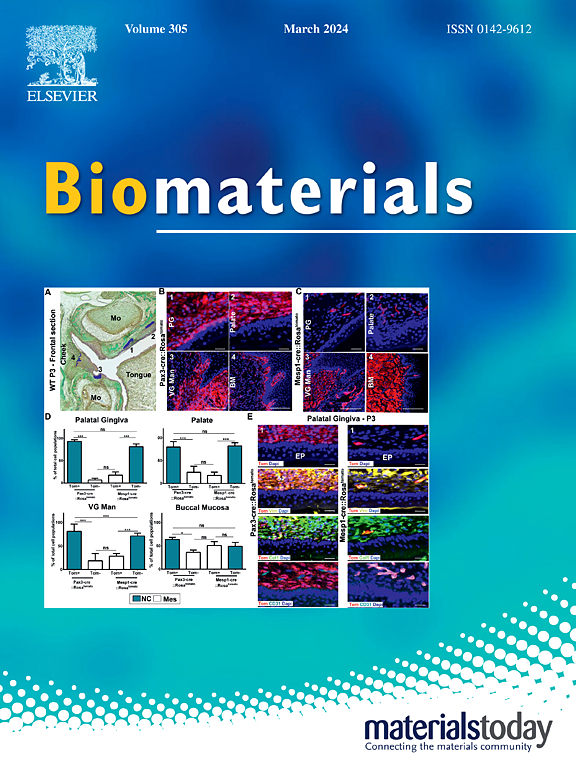In situ incorporation of boronate into carbonized alginate nanogels for targeted inhibition of triple-negative breast cancer metastasis by inducing cytoskeletal disruption, cell growth arrest, and apoptosis
IF 12.8
1区 医学
Q1 ENGINEERING, BIOMEDICAL
引用次数: 0
Abstract
Metastasis is the primary cause of cancer mortality, and its prevention is particularly challenging due to the complex tumor microenvironment. Carbon nanomaterials are well known to act as drug delivery systems for therapeutics. Nonetheless, their inherent capabilities in combating tumor cells remain underexplored. In this study, we report the synthesis and characterization of novel boronate-incorporated alginate carbon nanogels (Bor/Alg-CNGs) as promising anti-metastatic agents for effectively suppressing migration and invasion of triple-negative breast cancer (TNBC) cells, while triggering cell-cycle arrest. Notably, Bor/Alg-CNGs decreased cell viability of TNBC cells through disorganization of F-actin, a critical factor mediating cellular migration. In an in vivo study, Bor/Alg-CNGs reduced metastatic lung nodules in a tumor-induced mouse model by >85 %, compared to the untreated controls. Transcriptomics and proteomics analyses further validated the in vivo results with an in-depth understanding of the role of Bor/Alg-CNGs in the stress response of reactive oxygen species-induced cells and downregulation of the phosphatidylinositol 3-kinase/protein kinase B (PI3K/Akt) signaling pathway, leading to metabolic breakdown, cell growth arrest, and apoptosis. These findings underscore the potent anti-metastatic properties of Bor/Alg-CNGs based on their multifunctional role in inhibiting cellular mechanisms essential for metastasis. Compared to many existing carbon nanomaterials, Bor/Alg-CNGs offer enhanced specificity and efficiency in targeting metastatic pathways. Their ability to target and disrupt metastatic processes while minimizing side effects holds the potential for development as a new class of anti-metastatic agents in cancer therapy, warranting further mechanistic and clinical investigations to realize their full therapeutic potential.
将硼酸盐原位掺入碳化海藻酸钠纳米凝胶中,通过诱导细胞骨架破坏、细胞生长停滞和细胞凋亡,靶向抑制三阴性乳腺癌转移
转移是癌症死亡的主要原因,由于肿瘤微环境的复杂性,其预防尤其具有挑战性。众所周知,碳纳米材料可以作为治疗药物的递送系统。尽管如此,它们对抗肿瘤细胞的内在能力仍未被充分发掘。在这项研究中,我们报道了新型硼酸盐结合海藻酸碳纳米凝胶(Bor/Alg-CNGs)的合成和表征,作为一种有前途的抗转移药物,可以有效抑制三阴性乳腺癌(TNBC)细胞的迁移和侵袭,同时引发细胞周期阻滞。值得注意的是,Bor/Alg-CNGs通过破坏f -肌动蛋白(介导细胞迁移的关键因子)来降低TNBC细胞的活力。在一项体内研究中,与未治疗的对照组相比,Bor/Alg-CNGs使肿瘤诱导小鼠模型中的转移性肺结节减少了85%。转录组学和蛋白质组学分析进一步验证了体内结果,深入了解了Bor/Alg-CNGs在活性氧诱导的细胞应激反应中的作用,以及下调磷脂酰肌醇3-激酶/蛋白激酶B (PI3K/Akt)信号通路,导致代谢分解、细胞生长停滞和凋亡。这些发现强调了基于Bor/Alg-CNGs在抑制转移所必需的细胞机制中的多功能作用的有效抗转移特性。与许多现有的碳纳米材料相比,Bor/Alg-CNGs在靶向转移途径方面具有更高的特异性和效率。它们的靶向和破坏转移过程的能力,同时最大限度地减少了副作用,这为癌症治疗中的新型抗转移药物的发展提供了潜力,需要进一步的机制和临床研究来实现其全部治疗潜力。
本文章由计算机程序翻译,如有差异,请以英文原文为准。
求助全文
约1分钟内获得全文
求助全文
来源期刊

Biomaterials
工程技术-材料科学:生物材料
CiteScore
26.00
自引率
2.90%
发文量
565
审稿时长
46 days
期刊介绍:
Biomaterials is an international journal covering the science and clinical application of biomaterials. A biomaterial is now defined as a substance that has been engineered to take a form which, alone or as part of a complex system, is used to direct, by control of interactions with components of living systems, the course of any therapeutic or diagnostic procedure. It is the aim of the journal to provide a peer-reviewed forum for the publication of original papers and authoritative review and opinion papers dealing with the most important issues facing the use of biomaterials in clinical practice. The scope of the journal covers the wide range of physical, biological and chemical sciences that underpin the design of biomaterials and the clinical disciplines in which they are used. These sciences include polymer synthesis and characterization, drug and gene vector design, the biology of the host response, immunology and toxicology and self assembly at the nanoscale. Clinical applications include the therapies of medical technology and regenerative medicine in all clinical disciplines, and diagnostic systems that reply on innovative contrast and sensing agents. The journal is relevant to areas such as cancer diagnosis and therapy, implantable devices, drug delivery systems, gene vectors, bionanotechnology and tissue engineering.
 求助内容:
求助内容: 应助结果提醒方式:
应助结果提醒方式:


